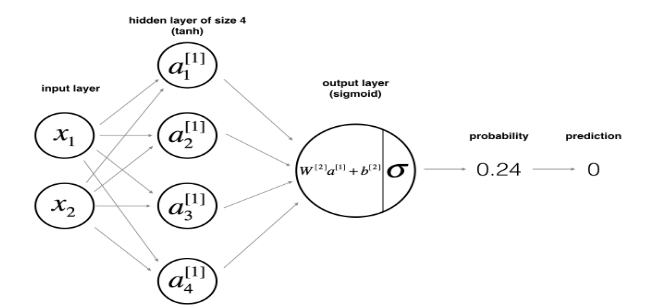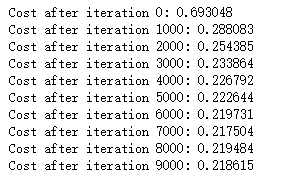实现一个单隐层神经网络python
仅仅记录神经网络编程主线。
一 引用工具包
import numpy as np
import matplotlib.pyplot as plt
from testCases import *
import sklearn
import sklearn.datasets
import sklearn.linear_model
from planar_utils import plot_decision_boundary, sigmoid, load_planar_dataset, load_extra_datasets %matplotlib inline np.random.seed() # set a seed so that the results are consistent
二 读入数据集
输入函数实现在最下面附录
X, Y = load_planar_dataset()
lanar是二分类数据集,可视化如下图,外形像花的一样的非线性数据集。
plt.scatter(X[, :], X[, :], c=Y, s=, cmap=plt.cm.Spectral);

- 特征 (x1, x2)
- 类别 (red:0, blue:1). 三 神经网络结构

对于输入样本x,前向传播计算如下公式:

损失函数J:

输入样本X:[n_x,m]; 假设输入m个样本,每个样本k维,输入神经元n_x个数=特征维度k,输出神经个数n_y=类别个数。
- W1:[n_h,n_x];
- b1:[n_h,1];
- W2:[n_y,n_h];
- b2:[n_y,1];
- trick:Wi第一维是第i+1层的神经元个数,第二维是第i层的神经元个数;bi第一维是第i层的神经元个数,第二维永远是1,因为python有broadcast机制,自动对齐。
def layer_sizes(X, Y):
"""
Arguments:
X -- input dataset of shape (input size, number of examples)
Y -- labels of shape (output size, number of examples)
Returns:
n_x -- the size of the input layer
n_h -- the size of the hidden layer
n_y -- the size of the output layer
"""
### START CODE HERE ### (≈ 3 lines of code)
n_x = X.shape[0] # size of input layer
n_h = 4
n_y = Y.shape[0] # size of output layer
### END CODE HERE ###
return (n_x, n_h, n_y)
四 初始化参数
W1,W2:不能初始化为0矩阵,如果这样第一个隐藏所有神经元梯度都和第一个一样: np.random.randn(a,b) * 0.01 .
b1,b2.:初始化为0向量 np.zeros((a,b)).
def initialize_parameters(n_x, n_h, n_y):
"""
Argument:
n_x -- size of the input layer
n_h -- size of the hidden layer
n_y -- size of the output layer
Returns:
params -- python dictionary containing your parameters:
W1 -- weight matrix of shape (n_h, n_x)
b1 -- bias vector of shape (n_h, 1)
W2 -- weight matrix of shape (n_y, n_h)
b2 -- bias vector of shape (n_y, 1)
"""
np.random.seed(2) # we set up a seed so that your output matches ours although the initialization is random.
### START CODE HERE ### (≈ 4 lines of code)
W1 = np.random.randn(n_h, n_x)*0.01
b1 = np.zeros((n_h, 1))
W2 = np.random.randn(n_y, n_h)*0.01
b2 = np.zeros((n_y, 1))
### END CODE HERE ###
assert (W1.shape == (n_h, n_x))
assert (b1.shape == (n_h, 1))
assert (W2.shape == (n_y, n_h))
assert (b2.shape == (n_y, 1))
parameters = {"W1": W1,
"b1": b1,
"W2": W2,
"b2": b2}
return parameters
五 前向传播
cache缓存计算结果,反向传播需要。
def forward_propagation(X, parameters):
"""
Argument:
X -- input data of size (n_x, m)
parameters -- python dictionary containing your parameters (output of initialization function)
Returns:
A2 -- The sigmoid output of the second activation
cache -- a dictionary containing "Z1", "A1", "Z2" and "A2"
"""
# Retrieve each parameter from the dictionary "parameters"
### START CODE HERE ### (≈ 4 lines of code)
W1 = parameters['W1']
b1 = parameters['b1']
W2 = parameters['W2']
b2 = parameters['b2']
### END CODE HERE ###
# Implement Forward Propagation to calculate A2 (probabilities)
### START CODE HERE ### (≈ 4 lines of code)
Z1 = np.dot(W1, X) + b1
A1 = np.tanh(Z1)
Z2 = np.dot(W2, A1) + b2
A2 = sigmoid(Z2)
### END CODE HERE ###
assert(A2.shape == (1, X.shape[1]))
cache = {"Z1": Z1,
"A1": A1,
"Z2": Z2,
"A2": A2}
return A2, cache
六 计算损失函数

def compute_cost(A2, Y, parameters):
"""
Computes the cross-entropy cost given in equation (13)
Arguments:
A2 -- The sigmoid output of the second activation, of shape (1, number of examples)
Y -- "true" labels vector of shape (1, number of examples)
parameters -- python dictionary containing your parameters W1, b1, W2 and b2
Returns:
cost -- cross-entropy cost given equation (13)
"""
m = float(Y.shape[1]) # number of example
# Compute the cross-entropy cost
### START CODE HERE ### (≈ 2 lines of code)
logprobs = np.multiply(np.log(A2),Y) + np.multiply((1-Y), (np.log(1-A2)))
cost = -1/m * np.sum(logprobs)
### END CODE HERE ###
cost = np.squeeze(cost) # makes sure cost is the dimension we expect.
# E.g., turns [[17]] into 17
assert(isinstance(cost, float))
return cost
七 反向传播
- 每个参数的维度
- dW1:[n_h,n_x];
- db1:[n_h,1];
- dW2:[n_y,n_h];
- db2:[n_y,1];
- trick:dW1,db1,dW2,db2和W1,b1,W2,b2的维度一模一样。

def backward_propagation(parameters, cache, X, Y):
"""
Implement the backward propagation using the instructions above.
Arguments:
parameters -- python dictionary containing our parameters
cache -- a dictionary containing "Z1", "A1", "Z2" and "A2".
X -- input data of shape (2, number of examples)
Y -- "true" labels vector of shape (1, number of examples)
Returns:
grads -- python dictionary containing your gradients with respect to different parameters
"""
m = float(X.shape[1])
# First, retrieve W1 and W2 from the dictionary "parameters".
### START CODE HERE ### (≈ 2 lines of code)
W1 = parameters['W1']
W2 = parameters['W2']
### END CODE HERE ###
# Retrieve also A1 and A2 from dictionary "cache".
### START CODE HERE ### (≈ 2 lines of code)
A1 = cache['A1']
A2 = cache['A2']
### END CODE HERE ###
# Backward propagation: calculate dW1, db1, dW2, db2.
### START CODE HERE ### (≈ 6 lines of code, corresponding to 6 equations on slide above)
dZ2= A2 - Y
dW2 =1/m * np.dot(dZ2, A1.T)
db2 =1/m * np.sum(dZ2, axis=1, keepdims=True)
dZ1 = np.dot(W2.T, dZ2) * (1 - np.power(A1, 2))
dW1 = 1/m * np.dot(dZ1, X.T)
db1 =1/m * np.sum(dZ1, axis=1, keepdims=True)
### END CODE HERE ###
grads = {"dW1": dW1,
"db1": db1,
"dW2": dW2,
"db2": db2}
return grads
八 梯度更新
优化过程,梯度更新: 使用 (dW1, db1, dW2, db2) 更新参数 (W1, b1, W2, b2).
梯度下降公式: 其中 α 是学习率.
其中 α 是学习率.
学习率: 如图所示,不同学习率,熟练情况不一样.
def update_parameters(parameters, grads, learning_rate = 1.2):
"""
Updates parameters using the gradient descent update rule given above
Arguments:
parameters -- python dictionary containing your parameters
grads -- python dictionary containing your gradients
Returns:
parameters -- python dictionary containing your updated parameters
"""
# Retrieve each parameter from the dictionary "parameters"
### START CODE HERE ### (≈ 4 lines of code)
W1 = parameters['W1']
b1 = parameters['b1']
W2 = parameters['W2']
b2 = parameters['b2']
### END CODE HERE ###
# Retrieve each gradient from the dictionary "grads"
### START CODE HERE ### (≈ 4 lines of code)
dW1 = grads["dW1"]
db1 = grads["db1"]
dW2 = grads["dW2"]
db2 = grads["db2"]
## END CODE HERE ###
# Update rule for each parameter
### START CODE HERE ### (≈ 4 lines of code)
W1 = W1 - learning_rate * dW1
b1 = b1 - learning_rate * db1
W2 = W2 - learning_rate * dW2
b2 = b2 - learning_rate * db2
### END CODE HERE ###
parameters = {"W1": W1,
"b1": b1,
"W2": W2,
"b2": b2}
return parameters
九 模型
将前面的函数整合成模型:
实现步骤:
1. 定义网络结构.
2. 初始化参数
3. Loop:
- 前向传播
- 计算损失函数
- 反向传播计算梯度
- 更新梯度def nn_model(X, Y, n_h, num_iterations = 10000, print_cost=False):
"""
Arguments:
X -- dataset of shape (2, number of examples)
Y -- labels of shape (1, number of examples)
n_h -- size of the hidden layer
num_iterations -- Number of iterations in gradient descent loop
print_cost -- if True, print the cost every 1000 iterations
Returns:
parameters -- parameters learnt by the model. They can then be used to predict.
"""
np.random.seed(3)
n_x = layer_sizes(X, Y)[0]
n_y = layer_sizes(X, Y)[2]
# Initialize parameters, then retrieve W1, b1, W2, b2. Inputs: "n_x, n_h, n_y". Outputs = "W1, b1, W2, b2, parameters".
### START CODE HERE ### (≈ 5 lines of code)
n_x, n_h, n_y = layer_sizes(X, Y)
parameters = initialize_parameters(n_x, n_h, n_y)
W1 = parameters['W1']
b1 = parameters['b1']
W2 = parameters['W2']
b2 = parameters['b2']
### END CODE HERE ###
# Loop (gradient descent)
for i in range(0, num_iterations):
### START CODE HERE ### (≈ 4 lines of code)
# Forward propagation. Inputs: "X, parameters". Outputs: "A2, cache".
A2, cache = forward_propagation(X, parameters)
# Cost function. Inputs: "A2, Y, parameters". Outputs: "cost".
cost = compute_cost(A2, Y, parameters)
# Backpropagation. Inputs: "parameters, cache, X, Y". Outputs: "grads".
grads = backward_propagation(parameters, cache, X, Y)
# Gradient descent parameter update. Inputs: "parameters, grads". Outputs: "parameters".
parameters = update_parameters(parameters, grads)
### END CODE HERE ###
# Print the cost every 1000 iterations
if print_cost and i % 1000 == 0:
print ("Cost after iteration %i: %f" %(i, cost))
return parameters
十 预测
- 对于一个样本,预估概率大于阈值0.5的为1,否则为0.

def predict(parameters, X):
"""
Using the learned parameters, predicts a class for each example in X
Arguments:
parameters -- python dictionary containing your parameters
X -- input data of size (n_x, m)
Returns
predictions -- vector of predictions of our model (red: 0 / blue: 1)
"""
# Computes probabilities using forward propagation, and classifies to 0/1 using 0.5 as the threshold.
### START CODE HERE ### (≈ 2 lines of code)
A2, cache = forward_propagation(X, parameters)
predictions = np.array( [1 if x >0.5 else 0 for x in A2.reshape(-1,1)] ).reshape(A2.shape) # 这一行代码的作用详见下面代码示例
### END CODE HERE ###
return predictions
planar数据集测试单隐层神经网络性能,隐层神经元个数设置为4.
# Build a model with a n_h-dimensional hidden layer
parameters = nn_model(X, Y, n_h = , num_iterations = , print_cost=True) # Plot the decision boundary
plot_decision_boundary(lambda x: predict(parameters, x.T), X, Y)
plt.title("Decision Boundary for hidden layer size " + str())
输出结果

附录:load输入数据集
import matplotlib.pyplot as plt
import numpy as np
import sklearn
import sklearn.datasets
import sklearn.linear_model def plot_decision_boundary(model, X, y):
# Set min and max values and give it some padding
x_min, x_max = X[, :].min() - , X[, :].max() +
y_min, y_max = X[, :].min() - , X[, :].max() +
h = 0.01
# Generate a grid of points with distance h between them xx, yy = np.meshgrid(np.arange(x_min, x_max, h), np.arange(y_min, y_max, h))
# Predict the function value for the whole grid
Z = model(np.c_[xx.ravel(), yy.ravel()])
Z = Z.reshape(xx.shape)
# Plot the contour and training examples
plt.contourf(xx, yy, Z, cmap=plt.cm.Spectral)
plt.ylabel('x2')
plt.xlabel('x1')
plt.scatter(X[, :], X[, :], c=y, cmap=plt.cm.Spectral) def sigmoid(x):
"""
Compute the sigmoid of x Arguments:
x -- A scalar or numpy array of any size. Return:
s -- sigmoid(x)
"""
s = /(+np.exp(-x))
return s def load_planar_dataset():
np.random.seed()
m = # number of examples
N = int(m/) # number of points per class
D = # dimensionality
X = np.zeros((m,D)) # data matrix where each row is a single example
Y = np.zeros((m,), dtype='uint8') # labels vector ( for red, for blue)
a = # maximum ray of the flower for j in range():
ix = range(N*j,N*(j+))
t = np.linspace(j*3.12,(j+)*3.12,N) + np.random.randn(N)*0.2 # theta
r = a*np.sin(*t) + np.random.randn(N)*0.2 # radius
X[ix] = np.c_[r*np.sin(t), r*np.cos(t)]
Y[ix] = j X = X.T
Y = Y.T return X, Y def load_extra_datasets():
N =
noisy_circles = sklearn.datasets.make_circles(n_samples=N, factor=., noise=.)
noisy_moons = sklearn.datasets.make_moons(n_samples=N, noise=.)
blobs = sklearn.datasets.make_blobs(n_samples=N, random_state=, n_features=, centers=)
gaussian_quantiles = sklearn.datasets.make_gaussian_quantiles(mean=None, cov=0.5, n_samples=N, n_features=, n_classes=, shuffle=True, random_state=None)
no_structure = np.random.rand(N, ), np.random.rand(N, ) return noisy_circles, noisy_moons, blobs, gaussian_quantiles, no_structure
参考:
实现一个单隐层神经网络python的更多相关文章
- 用C实现单隐层神经网络的训练和预测(手写BP算法)
实验要求:•实现10以内的非负双精度浮点数加法,例如输入4.99和5.70,能够预测输出为10.69•使用Gprof测试代码热度 代码框架•随机初始化1000对数值在0~10之间的浮点数,保存在二维数 ...
- Neural Networks and Deep Learning(week3)Planar data classification with one hidden layer(基于单隐藏层神经网络的平面数据分类)
Planar data classification with one hidden layer 你会学习到如何: 用单隐层实现一个二分类神经网络 使用一个非线性激励函数,如 tanh 计算交叉熵的损 ...
- 可变多隐层神经网络的python实现
说明:这是我对网上代码的改写版本,目的是使它跟前一篇提到的使用方法尽量一致,用起来更直观些. 此神经网络有两个特点: 1.灵活性 非常灵活,隐藏层的数目是可以设置的,隐藏层的激活函数也是可以设置的 2 ...
- ubuntu之路——day13 只用python的numpy在较为底层的阶段实现单隐含层神经网络
首先感谢这位博主整理的Andrew Ng的deeplearning.ai的相关作业:https://blog.csdn.net/u013733326/article/details/79827273 ...
- CS224d 单隐层全连接网络处理英文命名实体识别tensorflow
什么是NER? 命名实体识别(NER)是指识别文本中具有特定意义的实体,主要包括人名.地名.机构名.专有名词等.命名实体识别是信息提取.问答系统.句法分析.机器翻译等应用领域的重要基础工具,作为结构化 ...
- Andrew Ng - 深度学习工程师 - Part 1. 神经网络和深度学习(Week 3. 浅层神经网络)
=================第3周 浅层神经网络=============== ===3..1 神经网络概览=== ===3.2 神经网络表示=== ===3.3 计算神经网络的输出== ...
- tensorflow-LSTM-网络输出与多隐层节点
本文从tensorflow的代码层面理解LSTM. 看本文之前,需要先看我的这两篇博客 https://www.cnblogs.com/yanshw/p/10495745.html 谈到网络结构 ht ...
- 神经网络结构设计指导原则——输入层:神经元个数=feature维度 输出层:神经元个数=分类类别数,默认只用一个隐层 如果用多个隐层,则每个隐层的神经元数目都一样
神经网络结构设计指导原则 原文 http://blog.csdn.net/ybdesire/article/details/52821185 下面这个神经网络结构设计指导原则是Andrew N ...
- 1.4激活函数-带隐层的神经网络tf实战
激活函数 激活函数----日常不能用线性方程所概括的东西 左图是线性方程,右图是非线性方程 当男生增加到一定程度的时候,喜欢女生的数量不可能无限制增加,更加趋于平稳 在线性基础上套了一个激活函数,使得 ...
随机推荐
- 【化繁为简】非前端开发者的福音---CSS的预处理语言 Less&Sass
写在前面: 众所周知CSS 是一门非程序式语言,没有变量.函数.SCOPE(作用域),在前期的界面样式设计时,需要书写大量看似没有逻辑的代码,不方便维护及扩展,也不利于重复调用,尤其对于 ...
- Lucene第二篇【抽取工具类、索引库优化、分词器、高亮、摘要、排序、多条件搜索】
对Lucene代码优化 我们再次看回我们上一篇快速入门写过的代码,我来截取一些有代表性的: 以下代码在把数据填充到索引库,和从索引库查询数据的时候,都出现了.是重复代码! Directory dire ...
- Python生成器主要用法
代码如下: #!/usr/bin/env python3 # -*- coding: utf-8 -*- __author__ = '人生入戏' def use(name): print(" ...
- 关于sql语句引发的404错误
今天分享个小问题,也是今天在项目中遇到的,希望对遇到相关问题的朋友有所帮助. 使用工具:(相关的) mybatis,spring-mvc,mysql 问题原因: 我在mybatis的mapper文件中 ...
- [js高手之路] html5 canvas系列教程 - 开始路径beginPath与关闭路径closePath详解
路径在canvas绘图中,经常被用到,是一个非常重要的概念. 比如:我们要在canvas画出3条直线,要求用不同的颜色加以区分. <style> body { background: #0 ...
- TEXT宏
TEXT宏是windows程序设计中经常遇到的宏,定义在 <winnt.h>中 TCHAR *P = TEXT("this is a const string"); 如 ...
- hadoop 基本命令
hdfs相关 1.查看HDFS文件目录 hadoop fs -ls / mapreduce相关 1.查看mapred job mapred job -list hadoop job -list Use ...
- Json操作问题总结
大家都知道,Json是一种轻量级的数据交换格式,对JS处理数据来说是很理想滴! 熟练写过xxx.json文件和操作的小伙伴来说,我说的问题都不是什么大问题啦,可以忽略本宝宝的文章,更希望各位大佬指点一 ...
- Even Parity uva11464 模拟
Even Parity Time Limit: 3000MS Memory Limit: Unknown 64bit IO Format: %lld & %llu [Submit] ...
- HIVE---基于Hadoop的数据仓库工具讲解
Hadoop: Hadoop是一个由Apache基金会所开发的分布式系统基础架构.用来开发分布式程序.充分利用集群的威力进行高速运算和存储.Hadoop实现了一个分布式文件系统(Hadoop Dist ...
